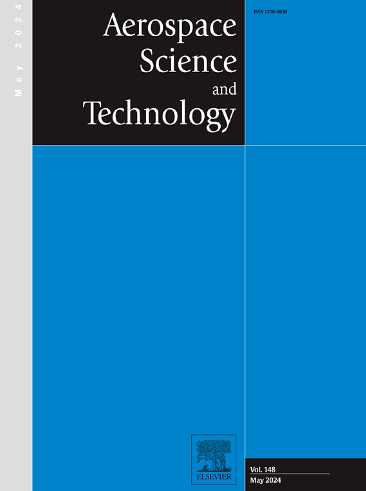Thermal non-equilibrium nonlinear coupled constitutive relations for hypersonic rarefied diatomic gas flows
IF 5
1区 工程技术
Q1 ENGINEERING, AEROSPACE
引用次数: 0
Abstract
The generalized hydrodynamic theory and its derived nonlinear coupled constitutive relations (NCCR) model have proven effective in simulating a range of typical hypersonic rarefied non-equilibrium flows, particularly in regimes where traditional Navier-Stokes (NS) equations are inadequate. However, the treatment of bulk viscosity has been limited, serving primarily as an approximation for rotational non-equilibrium effects, and lacking an explicit framework for energy exchange between different modes within the NCCR model. To address this limitation, this study introduces a thermal non-equilibrium NCCR model that operates without bulk viscosity, incorporating the Landau-Teller-Jeans relaxation model to facilitate explicit energy exchange between translational and rotational modes. The model's accuracy has been rigorously validated through a series of classical numerical cases, including analyzing nitrogen shock structures, supersonic flow over a flat plate, and hypersonic flows past blunt and flat-headed cylinders. The results demonstrate a significant improvement in alignment with experimental data and direct simulation Monte Carlo (DSMC) solutions compared to those derived from the NS equations and the original NCCR model lacking bulk viscosity. Furthermore, the proposed model enhances the predictive capability over the original NCCR framework and elucidates the mechanisms of non-equilibrium energy exchange between modes. These findings underscore the potential of the thermal non-equilibrium NCCR model as a robust and accurate tool for the simulation of hypersonic rarefied diatomic gas flows.
高超声速稀薄双原子气体流动的热非平衡非线性耦合本构关系
广义流体力学理论及其衍生的非线性耦合本构关系(NCCR)模型在模拟一系列典型的高超声速稀薄非平衡流动方面是有效的,特别是在传统Navier-Stokes (NS)方程不适用的情况下。然而,体粘度的处理是有限的,主要用作旋转非平衡效应的近似,并且缺乏NCCR模型中不同模式之间能量交换的明确框架。为了解决这一限制,本研究引入了一个热非平衡NCCR模型,该模型在没有体粘度的情况下运行,结合了Landau-Teller-Jeans松弛模型,以促进平动模式和旋转模式之间的显式能量交换。通过分析氮气激波结构、超声速流过平板、高超声速流过钝头和平头圆柱体等一系列经典数值实例,严格验证了该模型的准确性。结果表明,与NS方程和缺乏体黏度的原始NCCR模型相比,在与实验数据和直接模拟蒙特卡罗(DSMC)解的一致性方面有了显着改善。此外,该模型在原有NCCR框架的基础上提高了预测能力,并阐明了模式间非平衡能量交换的机制。这些发现强调了热非平衡NCCR模型作为模拟高超声速稀薄双原子气体流动的鲁棒和精确工具的潜力。
本文章由计算机程序翻译,如有差异,请以英文原文为准。
求助全文
约1分钟内获得全文
求助全文
来源期刊

Aerospace Science and Technology
工程技术-工程:宇航
CiteScore
10.30
自引率
28.60%
发文量
654
审稿时长
54 days
期刊介绍:
Aerospace Science and Technology publishes articles of outstanding scientific quality. Each article is reviewed by two referees. The journal welcomes papers from a wide range of countries. This journal publishes original papers, review articles and short communications related to all fields of aerospace research, fundamental and applied, potential applications of which are clearly related to:
• The design and the manufacture of aircraft, helicopters, missiles, launchers and satellites
• The control of their environment
• The study of various systems they are involved in, as supports or as targets.
Authors are invited to submit papers on new advances in the following topics to aerospace applications:
• Fluid dynamics
• Energetics and propulsion
• Materials and structures
• Flight mechanics
• Navigation, guidance and control
• Acoustics
• Optics
• Electromagnetism and radar
• Signal and image processing
• Information processing
• Data fusion
• Decision aid
• Human behaviour
• Robotics and intelligent systems
• Complex system engineering.
Etc.
 求助内容:
求助内容: 应助结果提醒方式:
应助结果提醒方式:


